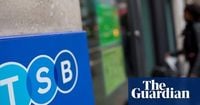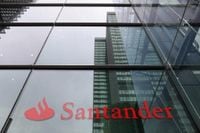In a significant move shaking up the UK banking landscape, Banco Santander announced on July 1, 2025, its agreement to acquire TSB Banking Group plc from Banco de Sabadell for £2.65 billion (approximately €3.1 billion) in an all-cash deal. This acquisition, expected to complete in the first quarter of 2026 pending regulatory and shareholder approvals, will create one of the largest banking groups in the UK, serving nearly 28 million customers.
TSB, a well-established high street bank with a 215-year history, operates 218 branches across the UK and serves around five million customers, primarily in personal and small business banking. It holds £34 billion in mortgages, representing about 2% of the UK mortgage market, and £35 billion in deposits. Santander UK, currently the country's fourth-largest mortgage lender, will integrate TSB into its existing operations, significantly boosting its market position.
Following the acquisition, Santander UK will become the third-largest bank in the UK by personal current account balances and rank fourth in mortgage lending. The combined entity will operate approximately 568 branches and serve close to 28 million retail and business customers nationwide, reinforcing Santander’s position as a core player in the UK financial services market.
The deal values TSB at roughly five times its expected 2026 net income and about 1.45 times its tangible book value as of March 31, 2025. The final price is anticipated to rise to £2.9 billion once TSB's estimated profits are factored in. Sabadell will also receive an additional €300 million representing TSB’s projected earnings until the deal closes.
Banco Sabadell’s decision to sell TSB comes amid a hostile €11 billion (£9.4 billion) takeover bid from rival BBVA, which has complicated Sabadell’s strategic outlook. Sabadell initially acquired TSB in 2015 for £1.7 billion, marking one of the most substantial cross-border banking deals since the financial crisis. The sale will allow Sabadell to distribute €3.8 billion in dividends over the next 12 months, equivalent to one-sixth of its capitalization.
TSB has undergone significant challenges in recent years, notably a disastrous IT system rollout in 2018 that locked millions of customers out of their accounts for weeks. This incident led to the resignation of then-chief executive Paul Pester and damaged the bank’s reputation. Since then, TSB has worked diligently to restore customer trust and improve its service standards.
Marc Armengol, TSB’s chief executive, expressed optimism about the acquisition, stating, “TSB is a truly special bank, run by a first-class team that deliver trusted service and support for customers, day in and day out. Today’s announcement represents the next exciting chapter for this successful business, as part of Santander, a highly regarded banking group. I believe this will prove to be an excellent fit for our loyal customers.”
From Santander's perspective, the acquisition aligns with its strategy of pursuing bolt-on acquisitions to accelerate organic growth in core markets while maintaining disciplined capital allocation. Ana Botín, Banco Santander’s executive chair, emphasized the strategic nature of the deal, saying, “The acquisition of TSB represents a continuing strategic commitment to our customers in the UK, offering a compelling opportunity that is financially attractive to our shareholders and aligned with Santander’s long-term objectives. It strengthens our franchise in a core market through the acquisition of a low-risk and complementary business that adds to our diversification.”
Financially, the transaction is expected to generate a return on invested capital exceeding 20%, boosting Santander UK’s return on tangible equity from 11% in 2024 to an anticipated 16% by 2028. Cost synergies of at least £400 million pre-tax, equivalent to 13% of the combined business’s cost base, are projected, although Santander anticipates incurring £520 million of pre-tax restructuring costs during 2026 and 2027 to realize these efficiencies.
Mike Regnier, CEO of Santander UK, highlighted the benefits for customers and the industry: “This is an excellent deal for customers combining two strong and complementary banks, creating one of the most substantial banks in the UK and materially enhancing the competitiveness of the industry. At Santander UK we have momentum in our strategy to become the best bank for customers in the UK by investing in technology and service and improving our processes and efficiency. This deal accelerates our transformation allowing us to enhance our customer proposition and invest more in innovative products and our digital offering, supported by the human touch service so many appreciate.”
However, the deal also raises concerns about potential job losses and branch closures as Santander integrates TSB into its operations. TSB currently employs roughly 5,000 staff across its 175 branches, while Santander UK has about 18,000 employees and 350 branches nationwide. The future of the TSB brand remains uncertain; Santander has not yet decided whether to retain or retire the name, which has been a fixture on the UK high street for over two centuries.
The acquisition marks TSB’s third major ownership change in just over a decade. Originally part of Lloyds Banking Group, TSB was spun off in 2013 as part of efforts to promote competition following Lloyds’ £20.3 billion government bailout. It was publicly floated in 2014 before being acquired by Sabadell the following year.
From a regulatory and shareholder perspective, the deal remains subject to approval by both UK regulators and Banco Sabadell’s shareholders. Santander expects the acquisition to consume approximately 50 basis points of CET1 capital at closing but has confirmed that the transaction will not affect its existing distribution policy or 2025 financial targets. The group is on track to deliver at least €10 billion in share buybacks from 2025 and 2026 earnings and excess capital on an accelerated timetable.
Santander’s proven track record in integrating UK banking platforms, having successfully acquired and merged Abbey in 2004 and both Alliance & Leicester and Bradford & Bingley in 2008, provides confidence in its ability to manage this complex transition. By combining technology platforms, Santander aims to unlock operational efficiencies and support long-term profitability through a simplified and scalable digital banking model.
As the UK banking sector continues to evolve amid regulatory pressures and competitive challenges, this landmark acquisition underscores Santander’s commitment to maintaining and expanding its footprint in a core market. The deal not only reshapes the competitive landscape but also signals a new chapter for TSB and its customers, who will soon become part of one of the UK’s most substantial banking groups.






